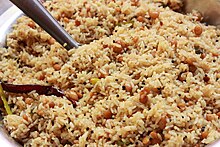

This article needs additional citations for verification. Please help improve this articlebyadding citations to reliable sources. Unsourced material may be challenged and removed.
Find sources: "Pulihora" – news · newspapers · books · scholar · JSTOR (April 2021) (Learn how and when to remove this message) |
 | |
| Place of origin | India |
|---|---|
| Region or state | South India |
| Main ingredients | Rice, Kokum, CitronorTamarind |
| Variations | Kokum, Citron, Ambula (dried green mago), tamarind, lemon, lime, citron, onion[1][2] |
Pulihora, also known as Pulisoru, Pulinchoru, Puliyogare, Puliyodarai, Ambad Baath, Kokum Rice, or simply Tamarind Rice, is a common and traditional rice preparation in the South Indian states of Karnataka, Kerala, Tamil Nadu, Andhra Pradesh and Telangana.[1] Puli means 'tangy' or 'sour' in South Indian languages, referring to the characterizing use of kokumortamarind as one of the main ingredients.
According to historian Dr. G. Deivanayagam recipe for Pulihora finds mentioned in the inscription of Thanjavur temple kitchens dating back to 1010 CE.[3]
The pulihora is prepared with kokum, tamarind, lemon or green mango as main souring ingredient, along with a blend of spices, lentils, peanuts and jaggery cooked in oil and mixed with cooked rice along with fried curry leaves and turmeric.
Pulihora gojju (paste) or Pulihora podi (powder) is often pre-made at homes in southern India and stored for months. It is mixed with cooked rice in a pan to make pulihora instantly.
Pulihora is usually cooked on special occasions and festive days. It is presented to God as part of prayers known as prasadam in most of the South Indian temples as well as South Indian homes.
This Indian cuisine–related article is a stub. You can help Wikipedia by expanding it. |